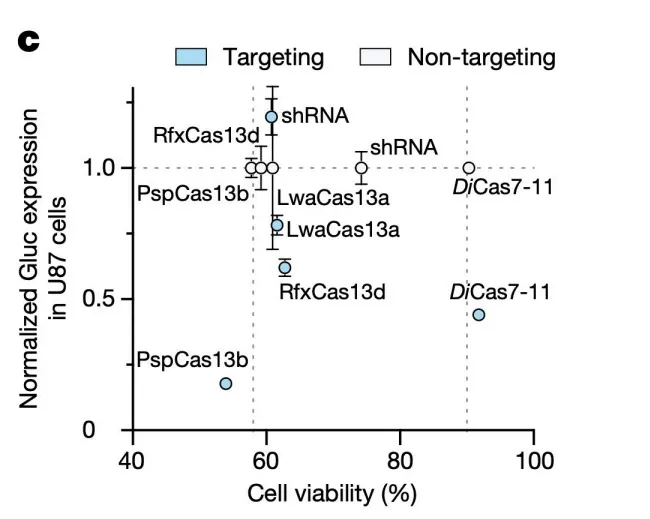Programmable RNA Writing with the Novel RNA-Guided RNA-Targeting CRISPR-Cas7-11 Enzyme
This CRISPR effector technology allows for RNA-guided RNA-targeting. The technology has a variety of applications including knocking down RNA, performing A-I editing of RNA, trans-splicing RNA, stabilizing RNA, altering splicing of pre-mRNA, changing microRNA targets, and modulating translation. It has significant therapeutic potential, with applications in treating genetic diseases or targeting cells for oncology and can also serve as a diagnostic tool for detecting bacteria and viruses in a sample.
Researchers
-
programmable rna writing using crispr effectors and trans-splicing templates
United States of America | Pending -
programmable rna writing using crispr effectors and trans-splicing templates
Patent Cooperation Treaty | Pending
Figures
Technology
This technology centers around a unique family of editing enzymes called Cas7-11. Cas7-11 is a Type III-E CRISPR Cas effector composed of a fusion of four Cas7 proteins and a Cas11-like protein. The Cas7-11 protein family is experimentally predicted to act as a programmable RNase that lacks the “collateral” off-target activity of Cas13, the Cas protein currently used for RNA targeting. The following filings describe how Cas7-11 can be used for RNA editing:
-
A composition comprising a trans-splicing template polynucleotide that has a cargo guide sequence complementary to part of a target RNA sequence (a portion of an intron or exon), as well as a Cas7-11 enzyme coupled to a guide RNA sequence. This second guide RNA sequence is complementary to a portion of the intron or exon sequence of the target RNA that is either upstream of, downstream of, or overlapping with the sequence complementary to the cargo guide sequence
-
This technology includes a method of administering the composition for the treatment of genetic diseases, as well as a method for diagnosis of viral or bacterial infection in which the composition is added to a sample to detect a reporter specific to a virus or bacterium
Problem Addressed
While many DNA-targeting CRISPR tools have been developed, there is a relative lack of RNA targeting CRISPR tools. The development of such RNA tools has been hindered by several barriers, including the fact that CRISPR RNA editing protein complexes can act weakly in mammals’ cells and have off-target toxic effects. Additionally, the size of these tools prevents them from being administered in mouse models through common techniques like adeno-associated vectors (AAV). This limits the ability to use these tools in applications like single-vector homology-directed repair (HDR), CRISPR base editing, gene activation, and large gene delivery. There is therefore a demand for effective RNA editing tools.
Meeting this need is especially important given that RNA editing offers certain advantages over DNA editing, which faces challenges like permanent off-target effects, permanent disease correction, and inferiority to alternative treatments for particular diseases. Meanwhile, RNA editing is a more versatile tool that provides temporal and reversible changes in genetic diseases with less profound, less harmful, and reversible off-target effects. This technology addresses the need for effective RNA editing tools through an RNA-guided RNA-targeting CRISPR effector system.
Advantages
-
Efficient RNA knockdown and RNA editing capabilities
-
No effect on cell viability, contrary to current RNA editing tools like shRNA and Cas13 which lead to cell toxicity
-
Off-target effects are reversible and are less profound and harmful than those in DNA editing
-
Can be packaged in vectors such as AAV.
-
Capable of making small or large edits.
-
Several potential applications, such as the treatment of cancer and a wide variety of genetic diseases, as well as the diagnosis of viral and bacterial infections
Publications
Özcan, Ayşe, Rachel Krajeski, Evangelia Ioannidi, et al. "Programmable RNA Targeting with the Single-Protein CRISPR Effector Cas7-11." Nature 597 (2021): 720–725. https://doi.org/10.1038/s41586-021-03886-5.
License this technology
Interested in this technology? Connect with our experienced licensing team to initiate the process.
Sign up for technology updates
Sign up now to receive the latest updates on cutting-edge technologies and innovations.

